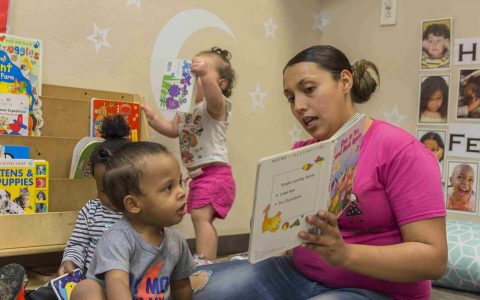As a group of preschoolers gather on a rug, their teacher holds up a card with the letter D and says, “I wonder what would happen if we changed the first sound of our name to a D sound. I’m going to go first. Instead of Mrs. Powers, I would be “Mrs…“ She pauses and
Category: Early Literacy
The Power of Positive Book Times: How Early Educators Can Spark a Love for Reading with Young Children
Whether you work with infants, toddlers or preschoolers, you have the power to share the joy of reading with the children in your care. This means more than having children’s books in your setting. Don’t get us wrong, having books is important, but how you use books makes a world of difference. Positive story times
Books and Beyond
Books and Beyond: Infusing Creativity into Reading Experiences A blanket, a snack and a good book. Is there any better way to enjoy a nice day at the park? For Arielle Deloney and the families in her program, it’s not just a great way to spend the day. It’s an intentional literacy practice. Deloney is
Quality in Action
Quality in Action At Quality First, we talk about quality early learning every day. But what does quality look like in action? Check out the clips below to see a few ways that Quality First teachers turn everyday moments into learning moments. Color Sorting Hints and Help Quality in action looks like: Rolling the mat
S is for Setting Goals: Creating an Effective Quality Improvement Plan
In Quality First, we use the VISION model to guide the quality improvement journey, and every journey needs a roadmap. In this third stage, you’ll focus on setting goals and creating action steps for quality improvement. This quality improvement plan is your roadmap. It outlines your goal (your destination), and the action steps you’ll take
Lullabies to letters: Developing language and literacy through music
The right music can change the mood of a learning environment. Music can invite children to get active and silly — or slow down and relax. Songs can also be effective in focusing children’s attention during transitions or when introducing new ideas. Music can act as a powerful tool that supports language and literacy development.
Playing with sounds: Phonological awareness prepares kids for reading
Reading is vital to a child’s ability to learn and be successful in school. Many skills like vocabulary, comprehension and print awareness support children’s reading abilities. However, one set of skills—phonological awareness—is particularly important and has been found to directly impact children’s reading success in kindergarten and beyond (Phillips, Menchetti & Lonigan 2008). Strong phonological
Tips for supporting literacy development
As an early childhood educator, your role is to lay the foundation for future literacy development. Helping children birth to age 5 connect written and spoken language and having meaningful experiences with print can be a challenge, but one effective strategy is dictation. Dictation–the process of writing children’s words and reading it back to them—helps







